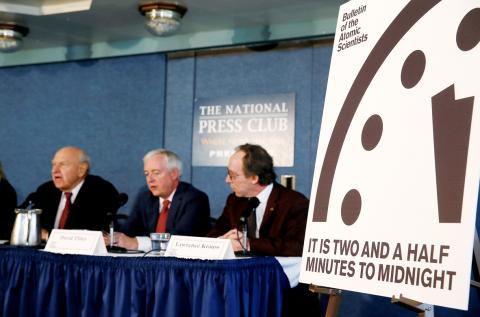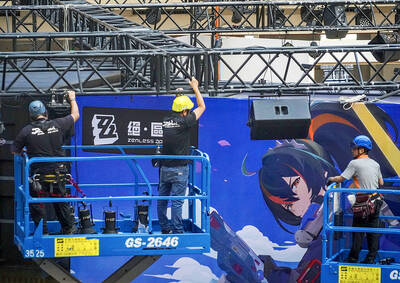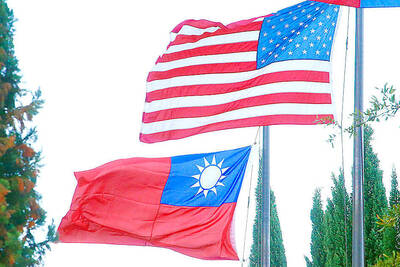It is getting closer to midnight.
On Thursday, the group of scientists who orchestrate the Doomsday Clock, a symbolic instrument informing the public when the Earth is facing imminent disaster, moved its minute hand from three to two-and-a-half minutes before the final hour.
It was the closest the clock had been to midnight since 1953, the year after the US and the Soviet Union conducted competing tests of the hydrogen bomb.

Photo: Reuters
Though scientists decide on the clock’s position, it is not a scientific instrument, or even a physical one. The movement of its symbolic hands is decided upon by the Science and Security Board of the Bulletin of the Atomic Scientists.
The organization introduced the clock on the cover of its June 1947 edition, placing it at seven minutes to midnight. Since then, it has moved closer to midnight and farther away, depending on the board’s conclusions.
Thursday’s announcement was made by Rachel Bronson, the executive director and publisher of the bulletin.
She was assisted by theoretical physicist Lawrence Krauss, climate scientist and meteorologist David Titley, and former US ambassador Thomas Pickering.
Bronson, in a post-announcement interview, explained why the board had included the 30-second mark in the measurement.
She said it was an attention-catching signal that was meant to acknowledge “what a dangerous moment we’re in, and how important it is for people to take note.”
“We’re so concerned about the rhetoric and the lack of respect for expertise that we moved it 30 seconds,” she said.
“Rather than create panic, we’re hoping that this drives action,” she said.
In an opinion piece for the New York Times, Titley and Krauss elaborated on their concerns, citing the increasing threats of nuclear weapons and climate change, as well as US President Donald Trump’s pledges to impede what they see as progress on both fronts, as reasons for moving the clock closer to midnight.
“Never before has the bulletin decided to advance the clock largely because of the statements of a single person,” they wrote. “But when that person is the new president of the United States, his words matter.”
In 1990, at the end of the Cold War, the clock was at 10 minutes to midnight. The next year, it was a full 17 minutes away, at 11:43.
However, over the next two decades the clock slowly ticked back. By 2015, the scientists were back in a state of unmitigated concern, with the clock at three minutes to midnight, the closest it had been since 1984.
“Unchecked climate change, global nuclear weapons modernizations, and outsized nuclear weapons arsenals pose extraordinary and undeniable threats to the continued existence of humanity,” the bulletin said.
“World leaders have failed to act with the speed or on the scale required to protect citizens from potential catastrophe,” it said.
“These failures of political leadership endanger every person on Earth,” it added.

Taiwan is projected to lose a working-age population of about 6.67 million people in two waves of retirement in the coming years, as the nation confronts accelerating demographic decline and a shortage of younger workers to take their place, the Ministry of the Interior said. Taiwan experienced its largest baby boom between 1958 and 1966, when the population grew by 3.78 million, followed by a second surge of 2.89 million between 1976 and 1982, ministry data showed. In 2023, the first of those baby boom generations — those born in the late 1950s and early 1960s — began to enter retirement, triggering

ECONOMIC BOOST: Should the more than 23 million people eligible for the NT$10,000 handouts spend them the same way as in 2023, GDP could rise 0.5 percent, an official said Universal cash handouts of NT$10,000 (US$330) are to be disbursed late next month at the earliest — including to permanent residents and foreign residents married to Taiwanese — pending legislative approval, the Ministry of Finance said yesterday. The Executive Yuan yesterday approved the Special Act for Strengthening Economic, Social and National Security Resilience in Response to International Circumstances (因應國際情勢強化經濟社會及民生國安韌性特別條例). The NT$550 billion special budget includes NT$236 billion for the cash handouts, plus an additional NT$20 billion set aside as reserve funds, expected to be used to support industries. Handouts might begin one month after the bill is promulgated and would be completed within

NO CHANGE: The TRA makes clear that the US does not consider the status of Taiwan to have been determined by WWII-era documents, a former AIT deputy director said The American Institute in Taiwan’s (AIT) comments that World War-II era documents do not determine Taiwan’s political status accurately conveyed the US’ stance, the US Department of State said. An AIT spokesperson on Saturday said that a Chinese official mischaracterized World War II-era documents as stating that Taiwan was ceded to the China. The remarks from the US’ de facto embassy in Taiwan drew criticism from the Ma Ying-jeou Foundation, whose director said the comments put Taiwan in danger. The Chinese-language United Daily News yesterday reported that a US State Department spokesperson confirmed the AIT’s position. They added that the US would continue to

IMPORTANT BACKER: China seeks to expel US influence from the Indo-Pacific region and supplant Washington as the global leader, MAC Minister Chiu Chui-cheng said China is preparing for war to seize Taiwan, Mainland Affairs Council (MAC) Minister Chiu Chui-cheng (邱垂正) said in Washington on Friday, warning that Taiwan’s fall would trigger a regional “domino effect” endangering US security. In a speech titled “Maintaining the Peaceful and Stable Status Quo Across the Taiwan Strait is in Line with the Shared Interests of Taiwan and the United States,” Chiu said Taiwan’s strategic importance is “closely tied” to US interests. Geopolitically, Taiwan sits in a “core position” in the first island chain — an arc stretching from Japan, through Taiwan and the Philippines, to Borneo, which is shared by